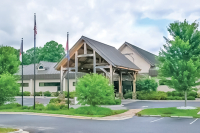Future big-box stores, strip malls to face scrutiny in Franklin
Franklin will soon have a new slate of comprehensive guidelines regulating development and promoting smart growth principles.
An overhaul of the town’s development ordinances has been four years in the making. The town board intends to pass the new regulations before November when three of the six board members face a crowded election.
A cornerstone of the ordinance is its treatment of commercial development with over 30,000 square feet, targeting big-box stores and strip malls. These large-scale commercial developments must come before the town board for a special use permit, allowing town leaders the opportunity to impose whatever guidelines they feel are necessary to make the development compatible with the community, such as landscaped parking lots and an attractive building design.
Alderman Bob Scott said it is time the town demanded respect from big commercial developers wanting to tap Franklin’s spending power.
“We have what every developer is foaming at the mouth to get a hold of,” Scott said. “It is not a one way street of what the developers can get out of Franklin. What we need to get out of them is what we will look like 20 or 30 years down the road. If a town board does not say, ‘This is the way we want you to go,’ they are going to do whatever they darn well please.”
Setting higher standards for large-scale commercial developments reflects the impacts they have on a community compared to a small business coming in, said town planner Mike Grubberman.
Related Items
“The little hairdresser does not have as large an impact as Wal-Mart or a guy who is building a strip mall,” Grubberman said. By requiring a special use permit for large-scale commercial developments, it “gives the town their bite of the apple,” Grubberman said.
The formula depends on a savvy town board, however. The level of discretion placed in the town board’s hands could leave the town vulnerable if the board doesn’t stick to its guns. Most developers try to bully small towns by threatening not to come unless the regulations are relaxed. It is usually a bluff, but requires town leaders to see through the process.
When seeking a special use permit, the developer will have to attend a public meeting with surrounding property owners — those within 400 feet of the development’s property line. The developer has to explain what he wants to build, answer questions posed by the residents, listen to their concerns and presumably alter his plans to make it more compatible.
“The developer has to come to that meeting or the project doesn’t move one inch beyond that,” Grubberman said. “The people have an opportunity up front at the beginning of the process to address their concerns.”
A starting point
Franklin’s current development regulations date back to the 1950s. The new guidelines are much needed, Grubberman said.
The ordinance will improve the look of commercial districts as new businesses come along and existing ones redevelop and come into compliance with the guidelines. For example, every development will have to include sidewalks. Ten percent of a commercial lot must be open space. Dumpsters have to be screened.
But in some areas, the ordinance is weaker on smart growth trends than those being used in other towns, such as Waynesville for example. While commercial developments over 30,000 square feet have to do whatever the town board asks in exchange for a special permit, developments under that size have relatively few guidelines to follow.
The average fast food joint would only have to plant two or three trees in its parking lot and no trees along the street front. There are no criteria governing the building’s appearance.
Grubberman called the ordinance a giant step, however.
“We are going from nothing to something significant here,” Grubberman said. “We will continue to take smaller steps as we go. The appearance code will come later.”
Alderman Verlin Curtis agreed.
“We had to have a starting place,” Curtis said.
Alderman Bob Scott hopes the town will toughen the requirements in the future, however.
“It is a first step,” Scott said. “The important thing is we are moving toward something. But I don’t think it is stringent enough.”
Scott said he would like to ramp up the number of trees required in parking lots and require design standards for buildings that would add to the community’s appearance rather than detract from it.
The ordinance requires higher standards for new development in the downtown district. Building facades downtown must meet architectural and aesthetic guidelines for starters. Buildings must be positioned in line with neighboring buildings to create a unified street wall, and a row of street trees is required.
“They can be summed up in one word: streetscape,” Grubberman said. “You want to have a look that everything is close and walkable, everything is kind of cohesive.”
There are also special appearance requirements for businesses in “mixed-use neighborhood districts.” These districts allow pockets of light business on the edge of residential neighborhoods — the fringe where commercial transitions into residential. Those districts require businesses to blend in architecturally.
“If someone wants to come into a neighborhood mixed-use district, they have to fit the neighborhood and not just be this sore thumb sticking out,” Grubberman said.
None of these criteria apply to the main commercial districts outside the downtown area, however.
The proposed ordinance has been in the making four years, when the town leaders embarked on a visionary process for the town and its future. The outcome was a set of guiding philosophies called the “Principles of Growth.”
“The Principles of Growth was to make Franklin a more attractive friendly atmosphere,” said Alderman Verlin Curtis, who was involved in the process. “It was how we envisioned a beautiful Franklin for the future.”
The next step was translating the philosophical ideals into a tangible ordinance that would guide development and growth in the way the town envisioned.









